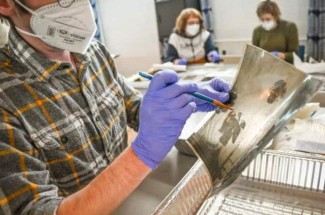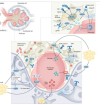UK takes the lead on preserving artistic, cultural heritage

Between December 2022 and August 2023, two major climate disasters devastated Kentucky communities. Along with the loss of life and property, there was a loss of cultural heritage. Artists’ livelihoods were threatened by the tornadoes that tore through Western Kentucky and the floods that overtook Eastern Kentucky. Archives of Appalachian heritage — Appalshop in Letcher County and Hindman Settlement School in Knott County — experienced damage, and even loss of video and audio tape and paper documents.
In the wake of those disasters, a loose coalition of stakeholders, including emergency managers, archivists, preservation professionals and leaders in Kentucky’s arts and humanities community, came together in informal conversations hosted by the Kentucky Arts Council about how to address what had already happened in Eastern and Western Kentucky, and how the arts and cultural community at-large could be better prepared for disasters in the future.
In early September, that coalition and the conversation became formalized as the Kentucky Heritage Emergency Response Network (KHERN) was launched at the Arts Disaster & Crisis Preparedness Conference, hosted by the University of Kentucky’s Department of Arts Administration. That conference was supported, in part, by a UK Land-grant Engagement grant.
KHERN was born out of the need to perpetuate the idea of always planning for the next disaster, says Leah Hamilton, the group’s lead network administrator and an assistant professor of arts administration.
“This group said, ‘All right, we’ve done really good work. We need to formalize. We can’t just always spontaneously come together every time there’s a need,’” Hamilton said.
Ruth Bryan, university archivist for UK’s Special Collections Research Center, is one of two of the university’s librarians in KHERN. She was part of a team of UK special collections librarians who deployed to Eastern Kentucky in the aftermath of the flood. They visited Appalshop in Letcher County and Hindman Settlement School in Knott County to help those repositories of Appalachian culture recover and, if possible, prepare media for restoration on or off site. It was an effort that was put together quickly, Bryan said, and which pointed to a stark truth.
“I was getting messages from different people not connected with each other, and they were searching the web for anyone who could help (with archiving),” Bryan said. “It was so disjointed and chaotic. We were clearly needing some kind of statewide organization to help.”
In addition to the Department of Arts Administration and the Special Collections Research Center, other UK academic and support programs are among the founding organizations in KHERN, including the College of Communication and Information and UK Cooperative Extension Service.
UK’s Cooperative Extension Service is integral to the networks KHERN leaders want to form, Hamilton says.
In addition to providing agents for agriculture, family and consumer sciences and 4-H in each of Kentucky’s 120 counties, UK Extension uses community arts agents to support creativity and the creative economy at a local level.
“What UK is doing, which I think is a model for the nation, is using the extension service as sort of the hub for the network,” Hamilton said. “We’re working with extension agents throughout the state, training them so that they can train their arts and cultural organizations in emergency preparedness and disaster response.”
Cooperative Extension is creating state level publications and resources related to navigating claims after a disaster, preparedness checklists customized for artists and arts organizations, and incorporating arts strategies into mental health support after a community level disaster. The service hosted one training course in Central Kentucky on Sept. 8 and plans to conduct trainings in Eastern and Western Kentucky in 2025.
“Partnering with UK Arts Administration allows us to distribute their research-based information through our extension agents in communities,” said Melissa Bond, Community Arts Extension program leader for the UK Cooperative Extension Service. Community Arts Extension is part of the Community and Economic Development Initiative of KY (CEDIK). “We hope this regional approach will allow artists and arts organizations to learn more about the topic and connect with other organizations in their areas.”
Other founders include state government partners the Kentucky Arts Council, Kentucky Humanities, the Kentucky Department of Libraries and Archives, the Kentucky Historical Society and the Kentucky Heritage Foundation. KHERN also has as a partner the Keeneland Library. At the national level, KHERN is supported by the Federal Emergency Management Agency, the Smithsonian Cultural Rescue Initiative, the National Coalition for Arts Preparedeness and Emergency Response and the Heritage Emergency National Task Force.
KHERN is supported by a $25,000 grant from LYRASIS through the Performing Arts Readiness project, an initiative of the Mellon Foundation.
For more information on KHERN, visit the organization’s website, khern.org.


